| |
Encounters: Facing “East”
|
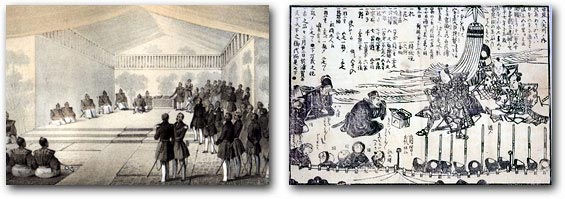 |
 “Delivery of the President's Letter” “Delivery of the President's Letter” |
 “Perry Taking a Bow” “Perry Taking a Bow” |
 |
 Detail,
from the official Narrative Detail,
from the official Narrative |
Ryosenji
Treasure Museum |
By far the greatest single source of American illustrations of the
Perry expedition is to be found in volume one of the three-volume
official Narrative published between 1856 and 1858. The most numerous
and accomplished
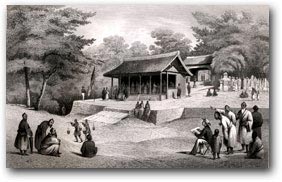
Heine sketching in the Ryukyu Islands,
1853, from the official Narrative |
of these illustrations were done by William Heine,
a German-born artist who was only 25 years old when he first
accompanied Perry to Japan.
Heine, who worked primarily with sketchpad and watercolors, brought a gentle,
panoramic, romantic realism to both the selection and execution of
his subjects. His landscapes were invariably scenic. Where people
were concerned, he preferred them in substantial numbers. He rarely
lingered on the “exotic,” did not dwell much (as happened
later) on various social “types,” did not seek out the
sensational. So enraptured was Heine by the opportunity to immerse
himself in new landscapes and cultures that, now and then, he even
painted himself painting the scene being depicted.
|
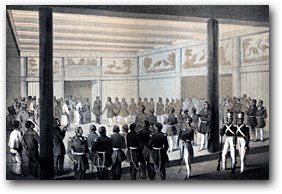 |

 Shui
Castle, Ryukyu Islands, Shui
Castle, Ryukyu Islands,
with two artists sketching the scene,
from the official Narrative
(detail below) |
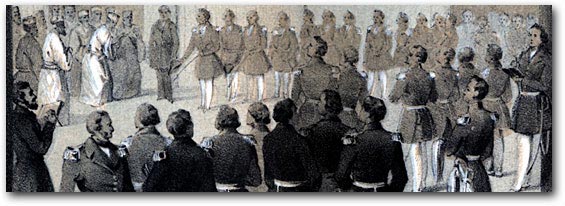
|
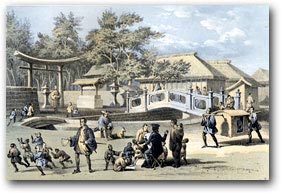
Entrance to Shinto shrine in Shimoda,
from the official Narrative (detail below)
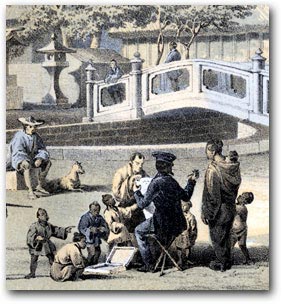 |
“Temples” attracted Heine (he, or whoever captioned
the reproductions of his artwork, made no distinction between Buddhist
temples and Shinto shrines), but he depicted them with the same appreciative
regard that he brought to trees, mountains, skies, crowds, individuals,
and other natural and human phenomena. He turned his brush (and also
his drawing pencil) to a few religious statues and monuments, but
again with restraint and respect—a striking contrast to the
more garish renderings of imagined heathen deities that had appeared
in Western publications prior to Perry’s arrival.
Since the Perry expedition never visited Edo or any other huge urban
center, the illustrations in the official report conveyed the impression
of a placid, rustic land of quiet villages and modest towns.
|
Heine and his colleagues gave only passing attention to commercial
activities, and only rarely entered behind closed doors. With but
one exception, they chose not to illustrate subjects that provoked
moral indignation among some members of the mission (and delighted
more than a few crewmen), such as prostitution, pornography, and public
baths.
The only illustration in the Narrative that subsequently provoked
shock and condemnation among Americans depicted a public bathhouse
in Shimoda. Men, women, and children bathed together in these establishments,
and good Christians found them appalling. Dr. James Morrow, the mission’s
botanist, denounced the bath in Shimoda as one more example “of
the licentiousness and degradation of these cultivated heathen,”
for example, while a ship’s clerk sourly observed that “their
religion might encourage cleanliness,” but it did so in a “repulsive
and indecent manner.” The official report itself recorded that
“a scene at the public baths, where the sexes mingle indiscriminately,
unconscious of their nudity, was not calculated to impress the Americans
with a very favorable opinion of the morals of the inhabitants.”

|
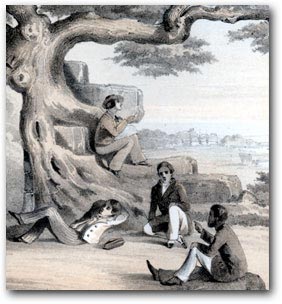
  Heine
and shipmates exploring the Ryukyu countryside, from the official Narrative (detail below) Heine
and shipmates exploring the Ryukyu countryside, from the official Narrative (detail below)
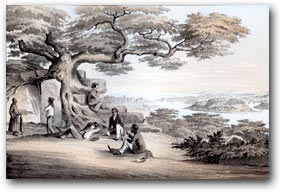 |
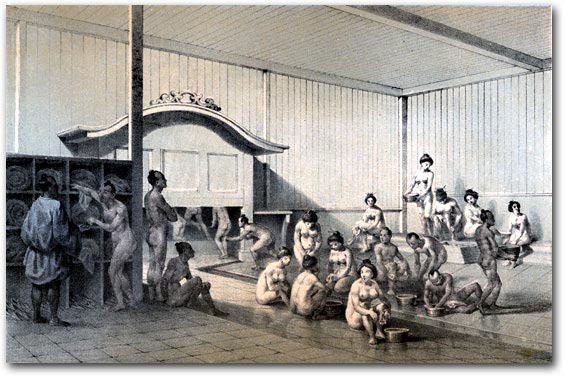 |
 Heine’s
controversial rendering of a public bath in Shimoda Heine’s
controversial rendering of a public bath in Shimoda |
Heine’s
illustration of the bathhouse in Shimoda was removed from later editions
of the Narrative. Where intercultural relations are concerned, morality
obviously was a two-way mirror in this case. For the manner in which
the Americans pointed to mixed bathing as evidence of Japanese lewdness
and wantonness was strikingly similar to John Manjiro’s response,
only a few years earlier, to the shocking spectacle of American men
and women kissing in public.
The original artwork by Heine and his colleagues was seen by very
few individuals. Rather, it reached the public in several different
forms. Some 34,000 copies of the official three-volume Narrative were
published (at the substantial cost of $400,000), of which over half
were given to high government officials, members of Congress, and
the Navy Department.
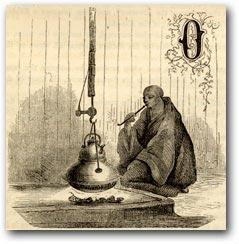
Chapter
heading drawing
from the official Narrative |
The first and most pertinent volume of the set included some 165 handsome
woodcuts and tipped-in lithographs depicting not only Japan but other
stops on the two voyages—including China, the Bonin islands,
and, of greatest interest, Okinawa in the Ryukyu (“Lew Chew”)
islands.
In
addition, this first volume also featured many small reproductions
of pencil drawings by Heine, particularly at the beginnings and ends
of chapters. Mid-century Western voyagers, artists, and scientists
were intent on “mapping” literally all aspects of the
little-known world, and in volume two several-score brilliantly colored
plates were devoted to natural life, particularly fishes and birds.
(Additional plates depicting the plants of Japan failed to be published
due to vanity and obstreperousness on the part of Dr. Morrow, who
collected and drew illustrations of hundreds of specimens, but held
these back in the hopes of seeing a separate publication devoted solely
to his own findings. This failed to materialize, and his work has
been lost.) The third volume of the Narrative, of little interest
today, reproduced charts of the stars recorded over the course of
the two long voyages.
 |
The
official publication was expensive, however, and the general public
only encountered this handsome visual record indirectly. An affordable
trade edition of volume one was published in 1856, with fewer lithographs
and color throughout reduced to black and white. At the same time,
a small number of illustrations (including some that did not appear
in the official or commercial publications) were reproduced as large
brightly colored “elephant” lithographs. One could thus
encounter "Perry’s Japan" in various tones and formats.
|
 |
Illustration
from the 1856
commercial edition |
  Tinted
lithograph from the Tinted
lithograph from the
official printing of 1856 |
Independent
large-format
lithograph, ca. 1855–56
|
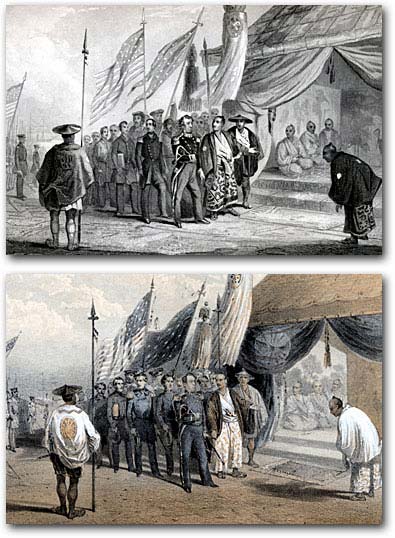 |
It also happened that, in moving from one form of printing to another,
the details of the original rendering were slightly altered—as
seen, for
example, in the famous depiction of Perry’s landing in Yokohama
that appears in the official and trade editions.
Two versions of
Commodore Perry meeting
officials at Yokohama
The trade edition of the
Narrative (detail, above left)
The official government
edition (detail, left)
 |
 |
| From the 1853 Expedition |
 |
The
artwork in the Narrative (and independent lithographs) begins with
impressions of ports of call en route to Japan (including scenes from
Ceylon, Singapore, Canton, and Hong Kong), and then presents a record
of major interactions between Perry and officials in “Lew Chew”
and Japan.
|
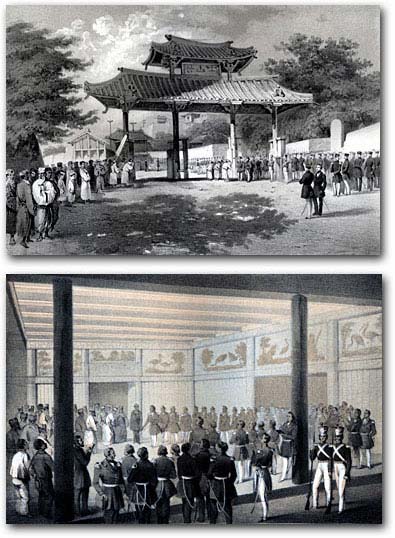 |
On the first visit to Okinawa, we move from the “exploring party”
mingling with native peoples in bucolic settings to the castle in
Naha, where Perry and his entourage paused by the imposing “Gate
of Courtesy” and then attended a crowded formal reception.
Gate of Courtesy
at the castle in Okinawa
(above, left)
Reception at Shui Castle, Okinawa (left)

|
Moving
on to Edo Bay, the artists recorded a tense moment when the Americans
began to survey the harbor and were briefly challenged by Japanese in small
boats—a dramatic confrontation, referred to as “Passing the Rubicon,” that was
inexplicably only made available as an independent print.
|
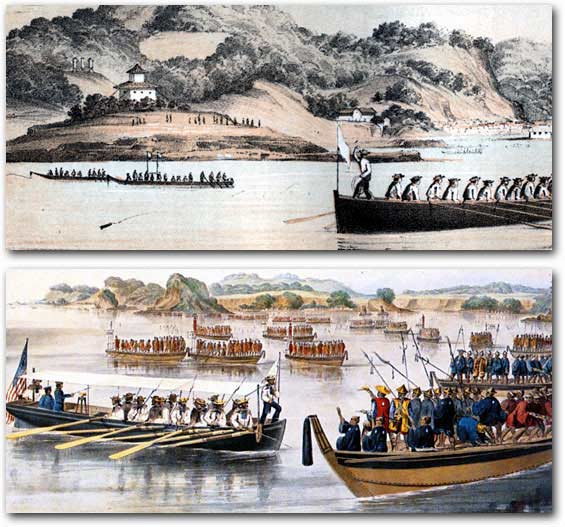 |
The White House Collection
|
The
Americans sounding and surveying Edo Bay (detail, top, from the official Narrative)
“Passing
the Rubicon”: Japanese officials confront the surveying party (detail, bottom)
|
Thereafter,
all becomes decorous again. From the brief 1853 mission come iconic
paintings of Perry coming ashore in Japan for the first time (on July
14, at Kurihama) and delivering President Fillmore’s letter
requesting the end of the policy of seclusion.
|
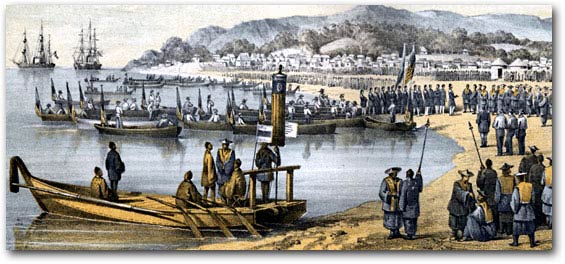 |
 The
landing at Kurihama The
landing at Kurihama
(detail)
Delivery of President
Fillmore’s letter
|
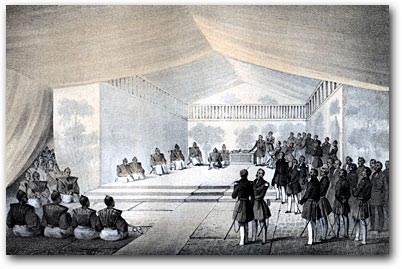 |
 |
| From the 1854 Expedition |
 |
The
commodore’s return visit in 1854, which lasted for several months
and saw the opening of Shimoda and Hakodate to foreign vessels, provided
the occasion for more extended artwork. Perry’s landing in Yokohama on March 8 inspired a crowded scene
of troops on parade before a horizon prickled with the masts of the
black ships, as well as a solemn rendering of the commodore greeting
the Japanese commissioners.
|
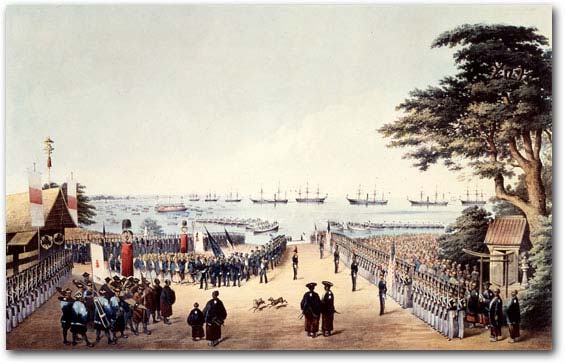 |
 The
landing at Yokohama (detail) The
landing at Yokohama (detail)
Yokohama Archives of History
|
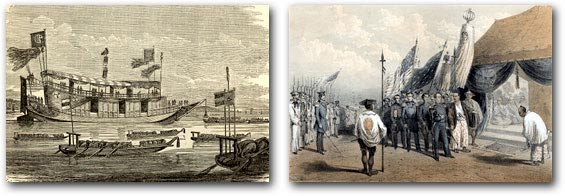 |
| “Imperial
barge” at Yokohama |
Japanese
officials greet Perry at Yokohama
|
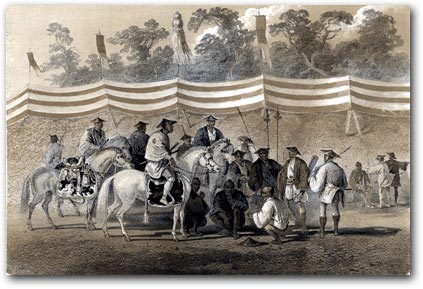 |
In
another illustration, armed samurai were depicted clustered together,
some mounted and some on foot (a rare close-up of the thousands of
warriors mobilized
for defense).
Samurai
defense forces
(detail) |
Formal
occasions— the presentation of American gifts, a banquet on
Perry’s flagship, a performance of sumo wrestling—were
duly recorded.
 Delivery
of the Delivery
of the
American presents
at Yokohama |
|
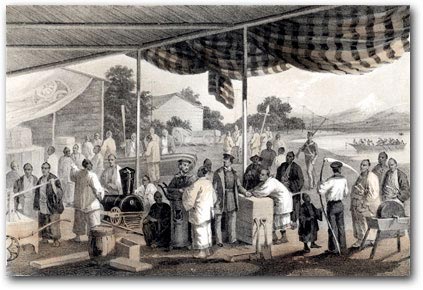 |
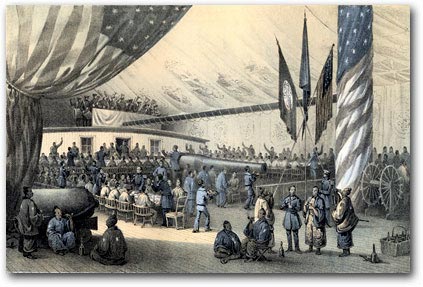 |

Banquet on board
the Powhatan |

 
Sumo wrestler
at Yokohama |
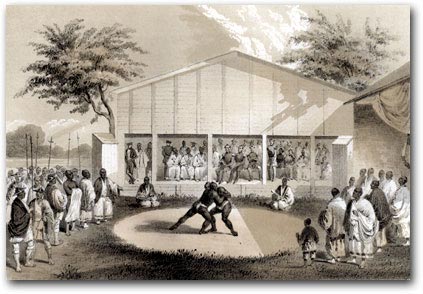 |
Yokohama,
and subsequently the newly designated “treaty ports” of
Shimoda and Hakodate, provided the Americans with more intimate access to the countryside
and the ordinary people who lived there.
The rugged vistas in these areas inspired Heine to new heights of
scenic romanticism, and he and his fellow artists also took advantage
of their excursions onshore to depict the local people and their places
of worship and daily activities (including the scandalous public bath
in Shimoda). Although these detailed scenes are usually crowded with
people, often with foreigners and natives intermingling, there is
little sense of tension or strangeness. The atmosphere is serene.
Everyone, native and foreigner alike, is comely. In the American record,
these first encounters come across as almost dream-like.
|
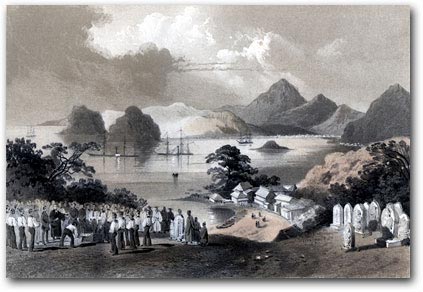 |


Shimoda “from the
American Grave Yard” |

 
Moonlit graveyard at Ryosenji Temple, Shimoda
Harvard University
Library |
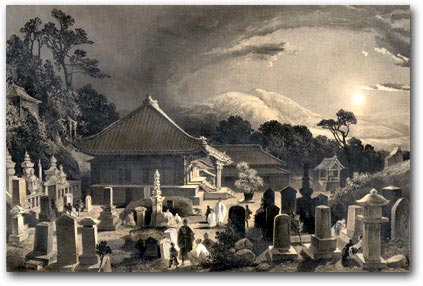 |
 |
| A Gallery of Images
from the Expedition |
 |
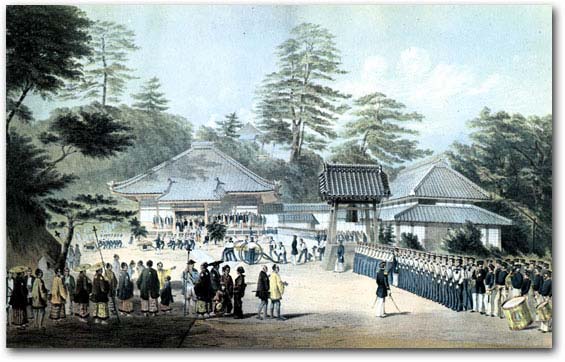 |
 Perry’s
troops in formation at Ryosenji Temple, Shimoda Perry’s
troops in formation at Ryosenji Temple, Shimoda
US Naval Academy Museum
|
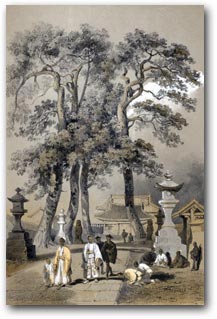 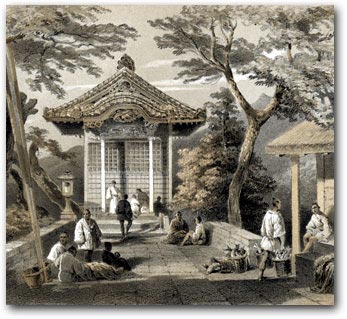 |
 Hachiman
shrine, Hachiman
shrine,
Shimoda |
  Mariner’s
temple, Mariner’s
temple,
Shimoda (detail)
|
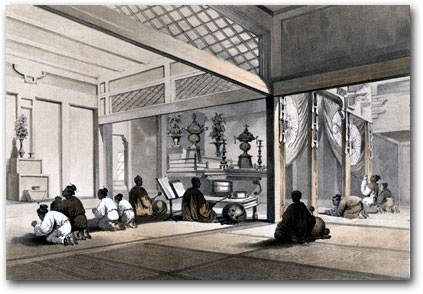
|
Devotions in a
Buddhist temple,
Shimoda |


Perry conferring
with local officials
in Hakodate |
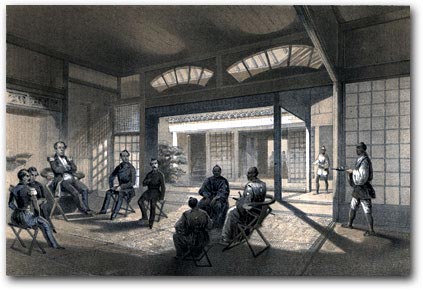
|
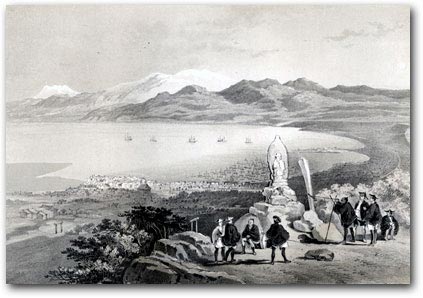
|

Hakodate
“from Telegraph Hill” |


Street by a temple
in Hakodate |
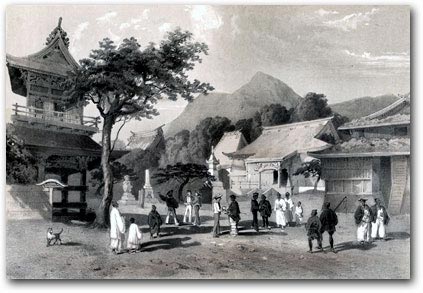
|
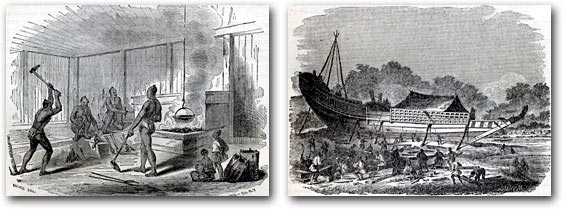 |
 Blacksmith
shop Blacksmith
shop |
 Shipyard Shipyard
|
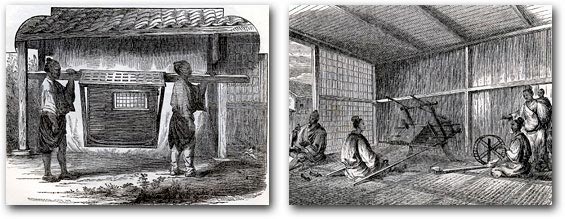 |
 Japanese
kago (palanquin) Japanese
kago (palanquin) |
 Spinning
and weaving Spinning
and weaving
|
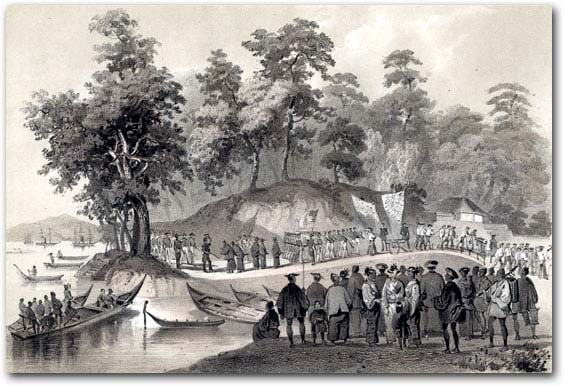 |
 Commodore
Perry bids farewell to officials in Shimoda Commodore
Perry bids farewell to officials in Shimoda
|
|
|

